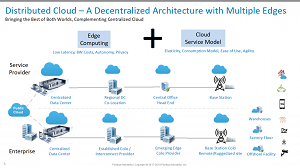News
Pluribus Pivots to the Distributed Cloud Edge
Pluribus Networks, firmly ensconced in the next-gen networking camp with software-centric, open networking offerings on bare-metal (or white-box) hardware, has updated those offerings with a distinct focus on the edge of distributed cloud implementations.
The company today announced Netvisor ONE 5.0, an open, secure and programmable next-generation network operating system based on Linux. Pluribus said it extends the Adaptive Cloud Fabric (software-defined, peer-to-peer, distributed, virtualized network architecture) in order to support emerging edge computing and distributed cloud architectures by providing greater scalability, automation and network-slicing capabilities.
The update was characterized as a significant milestone for the company, marking its expansion into a new market with a next-generation networking fabric solution for distributed cloud.
 [Click on image for larger view.] The Distributed Cloud (source: Pluribus Networks).
[Click on image for larger view.] The Distributed Cloud (source: Pluribus Networks).
Pluribus sees big things coming in that space. "The size of deployments to enable distributed clouds will be enormous, and will include implementations in service provider networks and on customer premises involving a rich mix of compute, networking, storage and orchestration resources," the company said in a blog post today (Feb. 27).
Version 5.0 of Netvisor ONE OS and the Adaptive Cloud Fabric have been extended to support distributed cloud edge compute sites in the following ways, as described by the company:
- Greater Scalability: Doubling the number of containerized FRR vRouter instances per switch for North-South traffic, now supporting up to 2,000 virtual routing and forwarding instances (VRFs) per network slice for East-West traffic.
- Improved Automation: VXLAN automated tunnel provisioning and management with end-to-end troubleshooting, now with flowtrace for deep flow visibility across the fabric.
- Enhanced Network Slicing: Doubling the number of containerized FRR vRouter instances per switch, further scaling the slicing across the management, control and data plane for full isolation of tenants and untrusted data like Internet of Things (IoT).
The company sees distributed cloud computing being driven by a confluence of factors, including advances in IoT, artificial intelligence and machine learning, which are producing more applications for virtual reality, video analytics, public safety and others with unique requirements for latency, bandwidth, autonomy and privacy.
"Success in edge computing will require elegant and efficient activation of distributed applications in a highly performant, scalable, and automated fabric which can support a diverse mix of deployment sites and optimize operations in both 'local cluster' and distributed application contexts," the company quoted Paul Parker-Johnson, chief analyst, ACG Research, as saying. "With its support of large scale 'whole stack' slicing, standards such as VXLAN for network virtualization, extensive automation for both deployment and operations, and its integration with top orchestration systems for managing cloud infrastructure resources at scale, Pluribus' Adaptive Cloud Fabric is well-positioned for addressing the requirements of the industry's emerging distributed cloud and 5G networking deployments."
Netvisor ONE Release 5.0 will be available in the first quarter of this year, Pluribus said, and is compatible with a broad set of 10GbE, 25GbE and 100GbE open networking switches.
About the Author
David Ramel is an editor and writer at Converge 360.